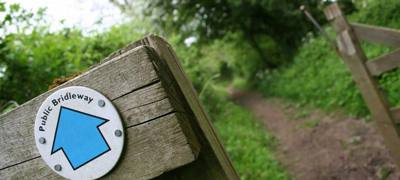This policy applies to England and Wales, and will hopefully explain the process to those equestrians concerned about the installation of a gate on a restricted byway.
The process
- Where it has been proven by a local highways authority that a problem exists of unauthorised use with four-wheeled motor vehicles (other than quad bikes) on a restricted byway (or a byway or road subject to a Traffic Regulation Order prohibiting use with motor vehicles), we will press for the authority and police to run an enforcement exercise for a minimum period of 12 months, ideally 24 months.
- The trial period may include the provision of round bollards of a minimum of 600mm high, 1.8m apart, with ground between them maintained level and even, and the route kept clear of vegetation. Ideally, the bollards should be no less than 6m from the edge of a road to ensure that horse-drawn vehicles are clear of motor traffic when negotiating the gap.
- In cases where evidence during the trial period demonstrates that the 1.8m gap is not preventing use with four-wheeled motor vehicles (other than quad bikes), then we may consider a narrower gap of at least 1.6m between bollards.
- If the problem persists after the trial period (on a route not already subject to a Traffic Regulation Order), we may accede to the making of a Traffic Regulation Order to enable the erection of a gate with a 5ft gap alongside, if it has been clearly demonstrated that a gate is the only way to achieve the aims of the order.
- The gap must be passable by ridden horses. The gate must open to 90 degrees for the passage of horse-drawn vehicles and be maintained so that it remains easy to open and close.
- In exceptional cases where evidence demonstrates the need, we may accede to the gate being secured with a code lock for which the code is made available to local carriage drivers. How to acquire the code must be clearly advertised on site. The authority will need to maintain a record of people with the code to communicate, promptly, any changes and to maintain the lock and gate so they cause minimal inconvenience to legitimate users.
- The BHS will only accede to the making of a Traffic Regulation Order and installation of a gate if:
- There is provision for it to be reviewed after four years and, subject to that review, for the gate to be removed, as a trial if appropriate, and the order revoked, suspended or modified, if appropriate.
- The highways authority maintains on its website, a register, by parish, of Traffic Regulation Orders affecting public rights of way and any locked barriers.
- The proposed policy is less restrictive to users by allowing a narrower gap before a gate because it is considered likely that robustly installed bollards should be sufficient and that a wish for a gate, especially a locked gate, is rarely justified by evidence. This is a default response which causes gravest inconvenience to equestrians and other legitimate users and is unlikely to be justifiable in terms of the law under which a barrier may be authorised.


